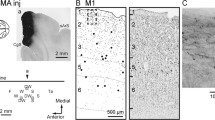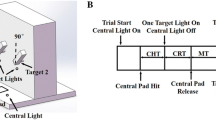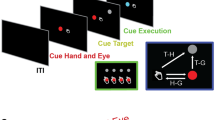Summary
Kinesthetic responses of neurones in the motor cortex, including the primary motor (MI), the supplementary motor (SMA) and the postarcuate premotor (PMC) areas, were investigated in the awake, chronically prepared monkey. In all three subareas, neurones were recorded which responded to passive elbow flexions and extensions induced by a torque motor. In the SMA, such cells were restricted to its posterior portion where intracortical microstimulation produced limb and trunk movements. The majority of SMA cells responds to both displacement directions, a quarter to either flexion or extension. Although the total proportion of SMA neurones responding to arm displacements was low (15%), it was noted that in ‘correct’ somatotopic penetrations, the responsiveness could be prominent. The latency distribution of the kinesthetic responses was similar to that of MI neurones with slightly less response latencies shorter than 20 ms in the SMA. With manually applied stimuli, SMA neurones responded mostly to joint rotations, but not to light cutaneous stimuli. Only two SMA neurones with somatosensory responses were identified as descending projection neurones, and some neurones were found to be modulated also during active grasping. In the PMC, a higher proportion of neurones (27%) reacted to the standardized arm displacements, the majority again responding to both directions. The latency distribution of the kinesthetic responses was similar to that of SMA neurones. In contrast to SMA neurones, many PMC neurones responded to light cutaneous stimuli. It was found that some of the ‘somatosensory’ PMC neurones were sometimes driven also by moving visual and, rarely, by auditory stimuli. Although there are obvious differences in the nature and possibly also in the amount of sensory inputs to the three motor cortical areas, the present results indicate that all three subareas receive somatosensory feedback and that they might therefore all be implicated in the generation of sensorydriven motor output.
Similar content being viewed by others
References
Bignall KE, Imbert M (1969) Polysensory and cortico-cortical projections to frontal lobe of squirrel and rhesus monkeys. Electroenceph Clin Neurophysiol 26: 206–215
Brinkman C, Porter R (1979) Supplementary motor area in the monkey. Activity of neurones during performance of a learned motor task. J Neurophysiol 42: 681–709
Brinkman C, Porter R (1983) Supplementary motor area and premotor area of monkey cerebral cortex: functional organization and activities of single neurons during performance of a learned movement. In: Desmedt JE (ed) Motor control mechanisms in health and diseases. Raven Press, New York, pp 393–420
Chavis DA, Pandya DN (1976) Further observation on corticofrontal connections in the rhesus monkey. Brain Res 117: 369–386
Crutcher MD, DeLong MR (1984) Single cell studies of the primate putamen. II. Relations to direction of movement and pattern of muscular activity. Exp Brain Res 53: 244–258
DeLong MR, Crutcher MD, Georgopoulos AP (1985) Primate globus pallidus and subthalamic nucleus: functional organization. J Neurophysiol 53: 530–543
Fetz EE, Finocchio DV, Baker MA, Soso MJ (1980) Sensory and motor responses of precentral cortex cells during comparable passive and active joint movements. J Neurophysiol 43: 1070–1089
Gallouin F, Albe-Fessard D (1973) Stéréotaxie chez le macaque éveillé: étude des cortex somatique, moteur et moteur supplémentaire. J Physiol (Paris) 67: 274A
Godschalk M, Lemon RN, Kuypers HGJM, Ronday HK (1984) Cortical afferents and efferents of monkey postarcuate area: an anatomical and electrophysiological study. Exp Brain Res 56: 410–424
Goldberg G (1985) Supplementary motor area structure and function: review and hypotheses. Behav Brain Sci 8: 567–616
Goldberg G (1987) From intent to action. Evolution and function of the premotor systems of the frontal lobe. In: Perecman E (ed) The frontal lobe re-visited. IBRN Press (in press)
Hummelsheim H, Wiesendanger M, Bianchetti M, Wiesendanger R, Macpherson J (1986) Further investigations of the efferent linkage of the supplementary motor area (SMA) with the spinal cord in the monkey. Exp Brain Res 65: 75–82
Humphrey DR (1979) On the cortical control of visually directed reaching: contributions by nonprecentral motor areas. In: Talbot RE, Humphrey DR (eds) Posture and movement. Raven Press, New York, pp 51–112
Jones EG, Burton H (1976) Areal differences in the laminar distribution of thalamic afferents in cortical fields of the insular, parietal and temporal regions of primates. J Comp Neurol 168: 197–247
Jones EG, Coulter JD, Hendry SHC (1978) Intracortical connectivity of architectonic fields in the somatic sensory, motor and parietal cortex of monkeys. J Comp Neurol 181: 291–348
Jones EG, Powell TPS (1969) Connexions of the somatic sensory cortex of the rhesus monkey. I. Ipsilateral cortical connexions. Brain 92: 477–502
Künzle H (1978) An autoradiographic analysis of the efferent connections from premotor and adjacent prefrontal regions (areas 6 and 9) in Macaca fascicularis. Brain Behav Evol 15: 185–234
Kurata K, Tanji J (1985) Contrasting neuronal activity in supplementary and precentral motor cortex of monkeys. II. Responses to movement triggering vs. nontriggering sensory signals. J Neurophysiol 53: 142–152
Kurata K, Tanji J (1986) Premotor cortex neurons in macaques: activity before distal and proximal forelimb movements. J Neurosci 6: 403–411
Lemon RN, Hanby JA, Porter R (1976) Relationship between the activity of precentral neurones during active and passive movements in conscious monkeys. Proc R Soc (Lond) B 194: 341–373
Libet B, Wright EW, Gleason CA (1982) Readiness potentials preceding unrestricted ‘spontaneous’ vs. pre-planned voluntary acts. Electroenceph Clin Neurophysiol 54: 322–335
Liles SL (1985) Activity of neurons in putamen during active and passive movements of wrist. J Neurophysiol 53: 217–236
Macpherson JM, Marangoz C, Miles TS, Wiesendanger M (1982a) Microstimulation of the supplementary motor area (SMA) in the awake monkey. Exp Brain Res 46: 410–416
Macpherson J, Wiesendanger M, Marangoz C, Miles TS (1982b) Corticospinal neurones of the supplementary motor area of monkeys. A single unit study. Exp Brain Res 48: 81–88
Matsumura M, Kubota K (1979) Cortical projection to hand-arm motor area from post-arcuate area in macaque monkeys: a histological study of retrograde transport of horseradish peroxidase. Neurosci Lett 11: 241–246
Muakassa KF, Strick PL (1979) Frontal lobe inputs to primate motor cortex: evidence for four somatotopically organized ‘premotor’ areas. Brain Res 177: 176–182
Pandya DN, Kuypers HGJM (1969) Cortical-cortical connections in the rhesus monkey. Brain Res 13: 13–36
Petras JM (1971) Connections of the parietal lobe. J Psychiat Res 8: 189–201
Rizzolatti G, Scandolara C, Matelli M, Gentilucci M (1981a) Afferent properties of periarcuate neurons in macaque monkeys. I. Somatosensory responses. Behav Brain Res 2: 125–146
Rizzolatti G, Scandolara C, Matelli M, Gentilucci M (1981b) Afferent properties of periarcuate neurons in macaque monkeys. II. Visual responses. Behav Brain Res 2: 147–163
Sessle BJ, Wiesendanger M (1982) Structural and functional definition of the motor cortex in the monkey (Macaca fascicularis). J Physiol (Lond) 323: 245–265
Smith AM (1979) The activity of the supplementary motor area neurons during a maintained precision grip. Brain Res 172: 315–327
Strick PL (1983) The influence of motor preparation on the response of cerebellar neurons to limb displacements. J Neurosci 3: 2007–2020
Tanji J (1984) The neuronal activity in the supplementary motor area of primates. TINS 7: 282–285
Tanji J, Kurata K (1982) Comparison of movement-related activity in two cortical motor areas of primates. J Neurophysiol 48: 633–653
Tanji J, Kurata K (1985) Contrasting neuronal activity in supplementary and precentral motor cortex of monkeys. I. Responses to instructions determining motor responses to forthcoming signals of different modalities. J Neurophysiol 53: 129–141
Tanji J, Taniguchi K, Saga T (1980) Supplementary motor area: neuronal response to motor instructions. J Neurophysiol 43: 60–68
Thach WT (1979) Correlation of neural discharge with pattern and force of muscular activity, joint position, and direction of intended next movement in motor cortex and cerebellum. J Neurophysiol 41: 654–676
Vaadia E, Benson DA, Hienz RD, Goldstein MH (1986) Unit study of monkey frontal cortex: active localization of auditory and of visual stimuli. J Neurophysiol 56: 934–952
Weinrich M, Wise SP, Mauritz KH (1984) A neurophysiological study of the premotor cortex in the rhesus monkey. Brain 107: 385–414
Wiesendanger M (1981) Organization of secondary motor areas of cerebral cortex. In: Brooks VB (ed) Handbook of physiology, Vol II, Part I. Am Physiol Soc, Bethesda, pp 1121-1147
Wiesendanger M (1986) Recent developments in studies of the supplementary motor area of primates. Rev Physiol Pharmacol Biochem 103: 1–59
Wiesendanger M, Hummelsheim H, Bianchetti M (1985) Sensory input to the motor fields of the agranular frontal cortex: a comparison of the precentral, supplementary motor and premotor cortex. Behav Brain Res 18: 89–94
Wiesendanger M, Séguin JJ, Künzle H (1973) The supplementary motor area — a control system for posture? In: Stein RB, Pearson KC, Smith RS, Redford JB (eds). Plenum, New York, pp 331–346
Wise SP (1984) The non-primary motor cortex and its role in the cerebral control of movement. In: Edelman GM, Gall WE, Cowan WM (eds). John Wiley, New York, pp 525–555
Wise SP (1985) The primate premotor cortex: past, present, and preparatory. Ann Rev Neurosci 8: 1–19
Wise SP, Tanji J (1981) Supplementary and precentral motor cortex: contrast in responsiveness to peripheral input in the hindlimb area of the unanesthetized monkey. J Comp Neurol 195: 433–452
Author information
Authors and Affiliations
Rights and permissions
About this article
Cite this article
Hummelsheim, H., Bianchetti, M., Wiesendanger, M. et al. Sensory inputs to the agranular motor fields: a comparison between precentral, supplementary-motor and premotor areas in the monkey. Exp Brain Res 69, 289–298 (1988). https://doi.org/10.1007/BF00247574
Received:
Accepted:
Issue Date:
DOI: https://doi.org/10.1007/BF00247574




